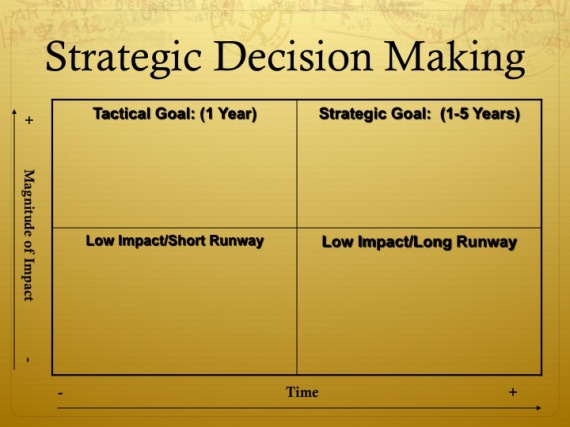What Are 2013’s Priorities?
What are my priorities for 2013? What accounts and what goals should I focus my efforts on? The time is now to think ask these questions. Do not wait until after the holidays.
These are key questions that will help me continue to grow and lead others to grow. Taking the time to get the answers to these questions does not have to be complicated.
Somewhere along the way I picked up a tool that helped me clear through the clutter of brainstorming sessions and simplified my action planning.

I sat in many, many strategy sessions for individuals, small teams and large organizations. They can be a beat down or very productive and energizing.
Brainstorm First, Then Qualify
During brainstorming, opinions of the ideas hurt the creative process. Opinions need to be controlled and held back until the brainstorming is over.
Impact and time to impact should not be evaluated during brainstorming. Once the brainstorming is over, it is time to qualify the ideas using the 4 Box Grid.
The most effective strategy sessions drew a clear line between brainstorming ideas and qualifying ideas. To qualify good ideas, I like to look at two things:
1. The Potential Magnitude Of The Impact of The Idea
Along the Y Axis of the 4 Box Grid above, I would plot whether the idea would have low impact or high impact (Revenue, relationships, etc.)
2. The Time Needed To Realize That Impact
Along the X Axis, I then determined whether the idea could realize that impact in the short term (within 12 months) or the long term (1-5 years).
Getting A Visual
By plotting the ideas in the proper quadrant, I could narrow down all the good ideas and find the best ones. Though I fell in love with some highly creative ideas, I might realize they required a longer runway and had lower potential impact than more mundane ideas.
Visualizing these ideas on the grid quickly made it clear to me where time and resources should be invested.
Priority #1
High value-short runway goals. These are my 12 month goals. They have the potential to move the ball down the field the furthest in the shortest period of time.
Priority #2
High value-long runway goals. These are strategic goals that need attention and strategic planning to obtain. This is the #2 priority for me because these will determine my future, my team’s future, or the future of the organization as a whole.
A leader must be able to envision the future and determine strategies that will ensure success beyond the next 12 months.
Priority #3
Low value-short runway goals. These are targets of opportunity. If you can get it done, do it. But, only if the opportunity is not replacing a higher impact goal.
Priority #4
Low value-long runway goals. Why? In my experience these are things that were historically done but rarely evaluated for impact. They are habits of operating that need to be eliminated.
The Bottom Line:
Too many strategy sessions I sat in were simply brainstorming run amuck. A lot of great ideas where thrown up on a flip chart and discussed. We got bogged down during brainstorming sessions when people tried to qualify ideas during the brainstorming.
Plus, the qualifying often revolved around how to implement an idea instead of discussing whether we SHOULD spend the time and resources to implement them.
New ideas are great. The creative ones capture my imagination easily. But if I don’t understand their potential impact and how long it will take to realize that impact, I am in danger of moving in the wrong direction in the next 12 months.
Question:
How are you going to qualify your goals and priorities for 2013?

